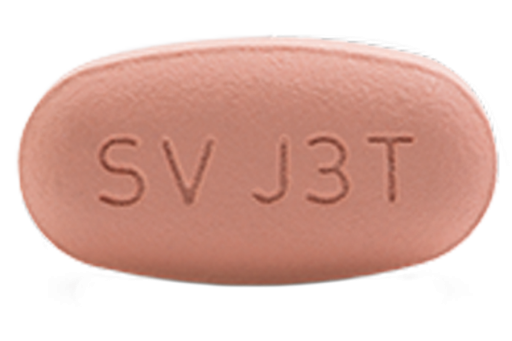Juluca
50 mg dolutegravir, 25 mg rilpivirine DTG (INSTI), RPV (NNRTI)

Standard Dose
One tablet once daily, with a meal (SEE Edurant), for adults who are virologically suppressed (have an undetectable viral load of less than 50 copies per mL) on a current ART (antiretroviral therapy) regimen for at least six months and who have no history of treatment failure or resistance mutations associated with rilpivirine or dolutegravir.Take missed dose as soon as possible, with a meal, unless it is closer to the time of your next dose. Do not double up on your next dose. For proper absorption, rilpivirine must be taken with a meal that you chew—not just nutritional drinks or protein shakes.
- See the individual drugs contained in Juluca: Tivicay and Edurant.
- See package insert for more complete information on potential side effects and interactions.
Manufacturer
ViiV Healthcareviivhealthcare.com; juluca.com
(877) 844-8872
AWP
$3,978.37/monthPotential Side Effects and Toxicity
Both dolutegravir and rilpivirine are generally well tolerated. Side effects observed in greater than 2% of study participants were diarrhea and headache. Data associate INSTIs with weight gain. Dolutegravir and rilpivirine can each cause a small, reversible increase in a kidney function test (serum creatinine) within the first few weeks of treatment without affecting actual kidney function. There have been rare reports of depression and suicidal ideation with INSTIs, primarily in people with a history of psychiatric illnesses. HHS guidelines recommend closely monitoring anyone with pre-existing psychiatric conditions. Liver enzymes should be monitored in people with hepatitis B or C and taking dolutegravir. Call your health care provider right away if you develop any of the following signs of hepatitis: yellowing of the skin or whites of the eyes; dark or tea-colored urine; pale-colored bowel movements; nausea or vomiting; loss of appetite; or pain, aching, or tenderness on the right side below the ribs.
Potential Drug Interactions
Do not take Juluca with rifampin, rifapentine, or the anti-arrhythmic dofetilide (a heart medication). If taking rifabutin, add an Edurant tablet to Juluca dose. If you take antacids, laxatives, or other products that contain aluminum, calcium carbonate, magnesium, or buffered medicines, Juluca should be taken—with a meal, as always—at least 4 hours before or 6 hours after you take these medicines. Alternatively, these medications can be taken at the same time with Juluca and a meal. Take Juluca with a meal 4 hours before or 12 hours after you take H2 blocker acid reducers (Pepcid, Zantac, Tagamet). Juluca should not be taken with proton pump inhibitors (such as Aciphex, Dexilant, Prilosec, Prevacid, Protonix, Nexium). Avoid taking Juluca with some seizure medicines (carbamazepine, eslicarbamazepine, oxcarbazepine, phenobarbital, and phenytoin) or St. John’s wort. HHS HIV treatment guidelines suggest metformin be started at the lowest dose and titrated based on tolerability and clinical effect. Monitor for metformin adverse effects. When starting or stopping Juluca in people taking metformin, dose adjustment of metformin may be necessary to maintain optimal glycemic control. Not intended to be taken with other HIV medications, unless prescribed that way. Tell your provider or pharmacist about all medications, herbals, and supplements you are taking or thinking of taking, prescribed or not, as there are other drug interactions which are not listed here.
More Information
Juluca was the first two-drug combination approved as a complete regimen for HIV. It replaces a three- or four-drug therapy for people with undetectable viral loads who want to switch to a simpler or smaller tablet regimen. Juluca still works against two stages of the virus life cycle, as do the three-drug regimens. The guidelines cite Juluca as “a reasonable option when using nucleoside drugs is not desirable”—for example, due to previous toxicity—with an A1 rating (strong recommendation based on randomized controlled trials). Juluca is one of the smallest STRs, which may be advantageous to individuals who have difficulty swallowing. For individuals with HIV-2, commonly found outside the U.S., an NNRTI would not be recommended, as HIV-2 is inherently resistant to NNRTIs. Rilpivirine is an alternative drug for use during pregnancy, and although dolutegravir is now a preferred medication in pregnancy as well as for people who are trying to conceive, U.S. HIV perinatal treatment guidelines suggest using three-drug regimens. Find the discussion on page C-55 of perinatal guidelines at hivinfo.nih.gov. Pregnant individuals can voluntarily enroll in the Antiretroviral Pregnancy Registry through their provider; GO TO apregistry.com.
Doctor Comments
Dr. Melanie Thompson:
Juluca is not approved for initial therapy but is used for maintenance of viral suppression in people whose virus has been suppressed on their current regimen for at least 6 months. If you have hepatitis B, you must take another hepatitis B-active drug if you take Juluca, as neither of its components has activity against HBV. There are a number of drug interactions with Juluca (SEE drug interactions listed under Tivicay.) Juluca should be taken with a meal for best absorption of rilpivirine.
Weight gain, rash, insomnia, liver toxicity, and new or worsening depression have been noted with components of Juluca. Diarrhea and headache were its most common side effects in the SWORD clinical trials. A creatinine increase of about 0.1 mg/dL should be expected and is due to dolutegravir’s effect blocking kidney secretion of creatinine rather than kidney toxicity. (For further information about dolutegravir and rilpivirine, SEE Tivicay and Edurant.)
Because of similarities between cabotegravir and dolutegravir, some have suggested that Juluca might be used as a bridging drug if doses of Cabenuva cannot be given on time. This seems reasonable but has not been studied in clinical trials.
Activist Comments
Activist Joey Wynn:
Juluca was the first two-drug pill; seven years later, I believe the benefits do not outweigh the difficulties of this option. Many drug-drug interactions and numerous reports of diarrhea and headaches make this a difficult choice in today’s market. The timing of taking this with other pills such as vitamins and other over-the-counter products make this a complicated regimen to manage. I do not know of anyone still on this option; but I’m sure for a small handful of folks it works and they don’t want to switch. For people about to select a new therapy, this probably isn’t a good option to begin your journey, so keep looking.


